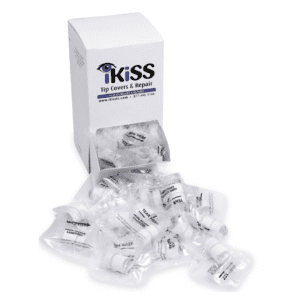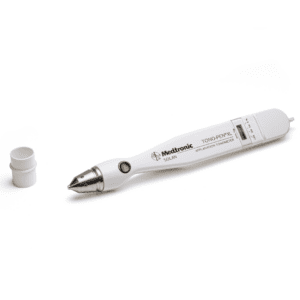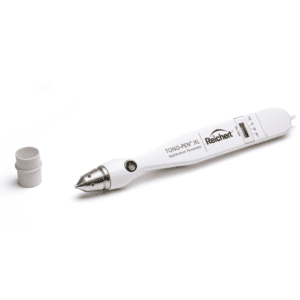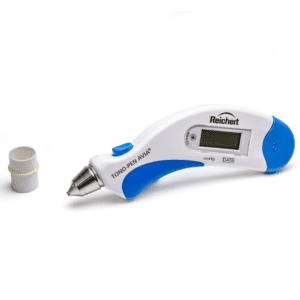Imagine this: It’s the year 2030, and you’re sitting at an eye exam. Your doctor steps away from traditional tonometers and introduces you to a high-tech device, promising a new era of tonometry. Welcome to the future of tonometry, a critical component in diagnosing and monitoring diseases like glaucoma, and it’s more advanced than ever before.
As we step into this exciting new stage, it’s time now to pierce through the mysteries of tomorrow and get a glimpse of what is on the horizon for tonometry.
There’s no need to pull out your crystal ball— we’ve got you covered with a comprehensive guide of what’s next for this essential eye examination procedure. So, sit back and join us on this journey to the future of tonometry.
Recent innovations in tonometry are pushing the boundaries, focusing on the biomechanical properties of the cornea to enhance accuracy. A tonometer is no longer just a device to measure intraocular pressure (IOP) – it has emerged as a tool to understand the intricacies of the eyes’ structure, providing valuable insights for eye health professionals. This shift is making a profound impact on how we diagnose and treat eye diseases.
The objective is now to develop tonometers that can not only measure the true IOP with precision but also capture the subtle differences in corneal biomechanical factors. And it doesn’t end there. The new-age tonometers are being designed to ensure practicality, too, making it possible for regular monitoring in both clinical and home environments.
This progress is not without its challenges, however. Every move forward in technology prompts an array of considerations for the medical community. Each tonometer in use comes with its unique strengths and limitations. Choosing the right tonometer depends on various factors, including, but not limited to, the specific clinical circumstances it’s intended for and whether it’s an in-office tool or screening device for larger populations.
Looking ahead, innovative solutions like dynamic contour tonometry are emerging as potential game-changers, promising more accurate IOP readings. Meanwhile, the advent of smartphone-based tonometers may prove revolutionary in maximizing access to ophthalmological care, especially in resource-poor regions where such services are critically needed. After all, the key to better vision care lies in accessibility and early detection.
In essence, the future of tonometry is no longer just about measuring pressure – it’s about understanding eyes better, ensuring precision diagnosis, and widening accessibility. As advancements continue to unfurl, one thing is for certain: The ophthalmic world is on the verge of a diagnostic revolution, and tonometry is at its forefront.
Some exciting developments on the horizon include innovative tonometry techniques, like dynamic contour tonometry. This approach works by contouring to the natural shape of the cornea, thereby avoiding the usual flattening or indentation seen in traditional methods. By doing so, it fosters precision, ensuring an accurate reading of the IOP, capturing a genuine reflection of the eye’s health.
Moreover, the ophthalmology field notes the emergence of systems engineered to characterize the biomechanical properties of the cornea. The central focus here is to optimize accuracy by minimizing the influence of variables such as corneal thickness and rigidity, a notable limitation in conventional techniques.
Factors, such as practicality, especially in the context of population screening and home settings, have gained increased importance in the design and functioning of these new-age tonometry devices. The goal is not only to make tonometry more accessible but also to enhance patient compliance, leading to long-term positives in vision care.
Navigating through these advancements, it’s clear that the future of tonometry holds promise. With this blend of precision, practicality, and accessibility, we’re gearing towards a new phase in eye health diagnostics. The aim is to victoriously mitigate vision impairment, one precise measurement at a time.
For close to five decades, Goldmann applanation tonometry (GAT) has set the benchmark for measuring intraocular pressure (IOP), forming a vital part of both clinical practice and research. This standard technique is currently being scrutinized anew, with scientific pioneers boldly inspecting its correlation to corneal thickness and curvature. These recent, innovative studies have laid the groundwork for future transformations in tonometry.
The rapidly evolving scene of ophthalmological technology has birthed the concept of dynamic contour tonometer (DCT). Known to offer refined readings, the DCT is designed to elucidate the biomechanical properties of the cornea, thus yielding a comprehensive understanding of intraocular pressure. The technologically advanced tonometer brings to the fore the possibility of turning in-house practices into home procedures. This paradigm shift is expected to translate into personalized eye care, facilitating more frequent and convenient IOP measurements for patients.
In an illuminating paper submitted by Tania Tai and Jody Piltz-Seymour, titled “Fundamentals and Advances in Tonometry”, the authors discuss numerous emerging tonometers. Their motive is clear: to find tools that generate measurements closely mirroring the true IOP. This thrust towards precision and practicality simultaneously assumes utmost gravity amidst the aspirations of tonometry’s future prospects.
Unwaveringly, the future holds a promise of highly accurate tonometry. This promise is echoed by numerous researchers, including Dr. Joel S. Schuman and the team of the Los Angeles Latino Eye Study, who are tirelessly investigating and comparing various tonometry methods. Their work is evidence of repealing entrenched approaches and adopting innovative procedures that consider the differing effects of IOP on corneal thickness and curvature.
The field is always in flux, and this is more true for tonometry than ever before. The journey seems arduous, but the destination is firmly in sight – a future where tonometry is not only more accurate and accessible but also tailored to each individual’s unique eye physiology. Stand by as we transition, pushing the boundaries of our knowledge and shaping our understanding of this vibrant field.
| Tonometer | Advantages | Limitations |
|---|---|---|
| Goldmann Applanation Tonometer | Industry standard for nearly half a century; reasonably accurate and reliable. | Affected by corneal thickness and curvature; requires local anesthetic; not suitable for home or field use. |
| MacKay-Marg Tonometer | Less affected by corneal thickness, according to some studies. | Controversy relating to its accuracy; further studies needed; requires local anesthetic. |
| Dynamic Contour Tonometer | Promising future advancement; potential for more accurate readings. | Still under development; not widely available or tested; requires specialist knowledge to operate. |
Another viable contender in the lineup of practical and functional tonometers is the Deceleration-based tonometer. Hailed for its patient-friendly characteristics, this type of tonometer offers the novel advantage of measuring Intraocular Pressure (IOP) without the need for anesthesia. IOP tracking easily transfers into the home setting, promoting ongoing patient engagement and monitoring.
Before we turn our attention towards clinical implementation, it’s crucial to acknowledge that the Deceleration-based tonometer isn’t without limitations. Its sensitivity to variations in corneal properties such as central corneal thickness, corneal hysteresis, and the corneal resistance factor, can impact IOP readings. Nevertheless, studies indicate its IOP readings show good agreement with the widely-accepted Goldmann and Tono-pen readings.
Your eye care routine could also get a boost from the iCare tonometer, an advanced tool that boasts a user-friendly interface and minimal discomfort. Generating readings analogous to the Goldmann Applanation Tonometer, it can potentially allow at-home IOP monitoring. However, it’s essential to bear in mind that these readings may sway under the influence of variations in the central corneal thickness (CCT).
While advancements in algorithms and technological innovations continue to enhance the accuracy of tonometry, each device carries its unique potential advantages and limitations. These advances hold the promise of greater accuracy, increased patient comfort, and improved preventative eye care. Passed down from the innovative Maklakoff tonometer of the 19th century, to the still-reliable Goldmann Applanation Tonometer developed by Dr. Hans Goldmann in the 1950s, tonometry has proven its adaptability and resilience.
| Tonometer Type | Developer/Innovator | Year | Prominent Feature |
|---|---|---|---|
| Maklakoff Tonometer | Not Specified | 19th Century | Early Precursor to Modern Tonometers |
| Goldmann Applanation Tonometer | Dr. Hans Goldmann | 1950s | Standard for IOP Measurement |
| iCare Tonometer | Not Specified | 2000s | Possible At-Home IOP Monitoring |
| Dynamic Contour Tonometer | Not Specified | Upcoming | Potentially More Accurate Readings |
So, where are we headed next? Well, the sector is brimming with possibilities. As our understanding broadens and we grow more proficient in manipulating these devices to our advantage, we inch ever closer toward perfecting this invaluable tool in the quest for better eye health.
What are smart contact lenses? Smart contact lenses are an emerging technology in ophthalmology that combine sensors and drug delivery systems. They are designed to monitor intraocular pressure and adjust drug release accordingly, potentially transforming glaucoma diagnosis and treatment. How can smartphone technology improve eye care? Advances in smartphone technology, like portable tonometer attachments and machine learning algorithms, can make eye care more accessible. It allows measurement of intraocular pressure remotely, making it an invaluable tool for those residing in rural or remote regions. What role does machine learning play in ophthalmology? Machine learning, especially unsupervised machine learning, can enhance automatic detection and calculation of intraocular pressure. This technology could improve the precision and reliability of pressure readings, which is key to managing eye conditions like glaucoma. What are intraocular pressure biosensors? Intraocular pressure biosensors are devices engineered to measure the pressure inside the eye accurately. These sensors, through advancements in technology, could provide a higher degree of precision in monitoring glaucoma. What is ocular pulse amplitude? Ocular pulse amplitude refers to the difference in intraocular pressure during the cardiac cycle. Recent researches are putting more focus on this parameter, which might offer new insights into the pathophysiology of glaucoma. Are smart contact lenses currently available for use? No, smart contact lenses are not yet available for commercial use. They are still undergoing further research, validation, and regulatory clearances. However, the potential of these lenses to revolutionize glaucoma management is evident and exciting.
As we salute the triumphs of past innovations and embrace present advancements in tonometry, the future looks bright and promising. The potential introduction of smart contact lenses, such as GlakoLens, and other wearable diagnostics like drug-eluting contact lenses, belie the onset of a transformative era for glaucoma management.
These extraordinary developments may not only provide accurate, real-time intraocular pressure (IOP) monitoring, but also pave the way for sustained drug release, improving medication adherence, and minimizing side effects. While the commercialization of these smart lenses may take a few more years due to rigorous research, validation, and regulatory clearances, the benefits they promise could dramatically shift glaucoma practice paradigms.
The pursuit of precision, practicality, and patient comfort in IOP monitoring is a journey, not a destination. The narrative of tonometry is one of ceaseless innovation and continuous improvement. And, with every technological advancement, we get one step closer to a future where glaucoma can be diagnosed and managed more effectively, enhancing patient care outcomes and quality of life.
Experiencing the evolution, embracing the present, and envisioning the horizon, one thing is clear – the future of tonometry is a compelling story worth watching unfold.
Keeping abreast of the dynamic field of tonometry is easier than ever. Check out ikisstc.com to stay up-to-date on the latest advancements, developments, and trends in tonometry. The future waits for no one – let’s journey into it together.
VISIT OUR SHOP





iKiSS is the go-to provider for top-quality refurbished Tono-Pen® Tonometers, Tono-Pen AVIA® Tonometers, Slit Lamps, and Phoropters, offering substantial savings of up to 40%.